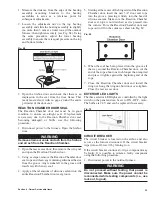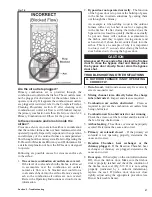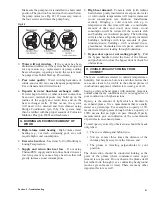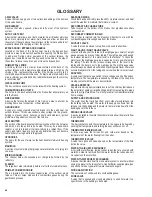
66
GLOSSARY
3-WAY VALVE
A valve that can supply one of two outlets, depending on the position
of the valve handle.
AIR BLEEDER
A device that, when opened, allows air to flow out of the hydronic
system.
AUTO FLOAT VENT
A device that will allow air out but not water. An air bleeder will close
when it is completely full of water. Auto floats can allow air back into
the system if they are above the water level in the furnace and are not
manually closed after purging air from the system.
BYPASS DOOR / BYPASS DOOR HANDLE
Located at the back of the firebox near the top, the bypass door
provides a way to redirect exhaust before opening the firebox door
to add wood. During normal operation of the outdoor furnace, the
bypass door remains closed. The bypass door handle on the side of
the outdoor furnace is used to open or close the bypass door.
CHIMNEY FALL ZONE
A chimney fall zone is a circular area centered at the back of the
outdoor furnace with a diameter approximately twice as high as the
chimney. This represents the area that if the chimney were to fall, it
could land anywhere within this zone. If objects are placed within this
area, a chimney guy-wire band kit or additional bracing on the chimney
is recommended.
CIRCULATION PUMP
The device that causes water to circulate within the heating system.
COMBUSTION AIR OUTLETS
The holes in the air channels inside the firebox that allow primary air
into the firebox.
FIRE BARRIER
A device that blocks the spread of fire from one area to another by
blocking flame, heat conduction, or heat radiation.
GROUND ROD
A copper or copper-coated steel rod driven into the earth near the
outdoor furnace. This device conducts stray voltage into the ground,
helping to prevent shock hazards, control board problems, ignition
problems, and galvanic corrosion of the furnace.
HEAT EMITTER
The portion of the heating system that removes heat from the hot water
and emits it into the space to be heated. This may be a baseboard
register, a coil in a forced air furnace, tubing in a radiant floor. If the
supply and return lines are not properly insulated, they will become
heat emitters moving heat into the ground.
HYDRONICS
The name for the use of water as the heat transfer medium in heating
systems.
MANIFOLD
A section of system piping that groups several branches of piping into
one area.
MIXING CHANNEL
The channel below the secondary air charge tube, formed by the
refractory.
PLENUM
The large duct area immediately before or after the forced-air furnace.
PRIMARY COMBUSTION AIR
The air injected into the firebox (upper) area of the outdoor wood
furnace. This air helps produce the combustible gases during the
gasification process.
SEASONED WOOD
Wood that has been dried to less than 25% moisture content, and kept
out of the weather to maintain that moisture content.
SECONDARY AIR CHARGE TUBE
Tube located on the bottom of the firebox that provides secondary
combustion air.
SECONDARY COMBUSTION AIR
The air that is injected into the Reaction Chamber to mix with the
combustible gases traveling down from the firebox.
SHUT-OFF VALVE
A valve that can be closed to stop flow or opened to allow flow.
SIGHT GAUGE / SIGHT GAUGE VALVE
Located at the back of the furnace, the sight gauge consists of a sight
gauge valve and a piece of clear tubing. The sight gauge can be used
as a visual indicator of the water level in the furnace. To check the
water level, the sight gauge valve is opened a ¼ turn so water enters
the tubing. The level in the furnace corresponds to the level in the
tubing and the decal next to the sight gauge. The sight gauge valve
should always be closed when finished checking water level. Water will
automatically drain from the tubing and valve when the valve is closed.
SNAP DISC
A component that acts as a switch to turn voltage on and off based on
temperature. The temperature is sensed by the face of the snap disc
making contact with the area to be monitored.
SPARK ARRESTOR
A spark arrestor is a device installed on top of the chimney that reduces
the potential of sparks or large flaming debris from escaping into areas
where they might start fires. It will not prevent all combustible material
from escaping.
SUPPLY AND RETURN LINES
The water lines that carry heat from your outdoor wood furnace into
the building to be heated. The water in the supply line flows from the
furnace into the building and the water in the return line flows from the
building back to the furnace.
SWING CHECK VALVE
A device installed in the water lines that will only allow the water to flow
in one direction.
THERMOSTAT
The device that controls the temperature in the space to be heated by
sensing that temperature and turning the heat emitters on or off.
THERMOSTATIC MIXING VALVE
A three way valve that mixes hot and cold water based on the
temperature of the water flowing from the outlet.
THERMOSTATIC VALVE
A valve that opens and closes based on the temperature of the fluid
inside the valve.
WATER-TO-AIR HEAT EXCHANGER
A coil with water flowing inside copper tubes that are covered with
metal fins. Heat is removed from the water inside the tubes when air
moves across the metal fins.
WATER-TO-WATER HEAT EXCHANGER
A device that transfers heat from one water system to another without
mixing the water in the two systems. Central Boiler supplies plate-type
and shell and tube type water to water heat exchangers.
WOOD GASIFICATION
The conversion of solid wood into combustible gases.
ZONE VALVE
A valve that is opened and closed electrically to send hot water to a
specific zone in the building to be heated.
Summary of Contents for e-Classic 1450 IR
Page 17: ...15 Section 1 Outdoor Furnace Installation...
Page 29: ...27 Section 1 Outdoor Furnace Installation Fig 30 Fig 31...
Page 30: ...28 Section 1 Outdoor Furnace Installation Fig 32 Fig 33...
Page 66: ...64 E CLASSIC 1450 WIRING DIAGRAM Section 6 General Information...
Page 67: ...65 Section 6 General Information E CLASSIC 1450 WIRING DIAGRAM OPTIONAL POWER IGNITION...
Page 69: ...67 NOTES...
Page 70: ...68 NOTES...
Page 71: ...69 NOTES...
































